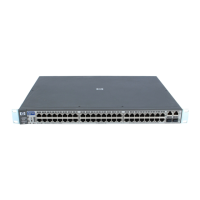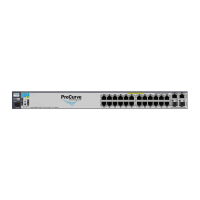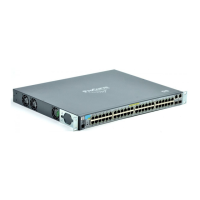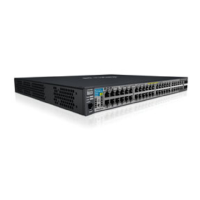11-30
Port-Based Virtual LANs (VLANs) and GVRP
Port-Based Virtual LANs (Static VLANs)
Figure 11-23. Example of Inadvertently Blocking a Management VLAN Link by
Implementing Spanning Tree
Effect of VLANs on Other Switch Features
Spanning Tree Operation with VLANs
Because the Switches 2650 and 6108 follow the 802.1Q VLAN recommendation
to use single-instance spanning tree, Spanning Tree operates across all ports
on the switch (regardless of VLAN assignments) instead of on a per-VLAN
basis. This means that if redundant physical links exist between the switch
and another 802.1Q device, all but one link will be blocked, regardless of
whether the redundant links are in separate VLANs. However, you can use
port trunking to prevent Spanning Tree from unnecessarily blocking ports
(and to improve overall network performance). Refer to “Spanning Tree
Operation with 802.1Q VLANs” on page 13-4.
Note that Spanning Tree operates differently in different devices. For example,
in the (obsolete, non-802.1Q) HP Switch 2000 and the HP Switch 800T, Span-
ning Tree operates on a per-VLAN basis, allowing redundant physical links as
long as they are in separate VLANs.
IP Interfaces
There is a one-to-one relationship between a VLAN and an IP network inter-
face. Since the VLAN is defined by a group of ports, the state (up/down) of
those ports determines the state of the IP network interface associated with
that VLAN. When a VLAN comes up because one or more of its ports is up, the
VLAN 20 (Management VLAN)
VLAN 1
VLAN 40
Switch
1
Switch
2
Even though the ports on the Management VLAN link between Switch 1 and Switch 2 do not belong
to the other VLANs connecting the two switches, enabling Spanning Tree will block one of the two
links. This is because Spanning Tree operates per-switch and not per-VLAN.
VLAN 1
VLAN 40
VLAN 20 Only
(Management VLAN)
Blocked
!Software.book Page 30 Thursday, October 10, 2002 6:10 PM

